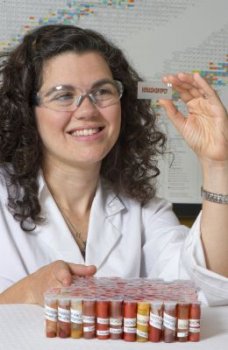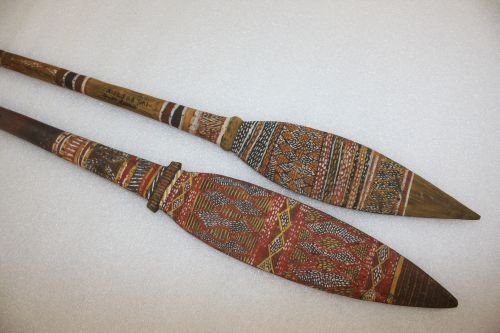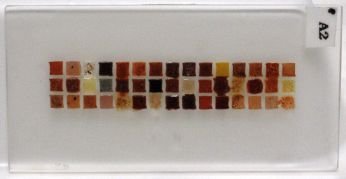South Australian researchers are using synchrotron techniques to investigate the origins of the ochres used in Aboriginal Australian artefacts – potentially revealing new information on ochre exchange routes and Aboriginal cultural relationships across Australia.
“Ochre mines are an integral part of the traditions and Dreaming stories of Indigenous Australians, and ochre was part of the cultural exchanges that took place across the continent,” says archaeological chemist Rachel Popelka-Filcoff.
 Left: Rachel Popelka-Filcoff with some of her ochre samples. Photo: Ashton Claridge, Flinders University
Left: Rachel Popelka-Filcoff with some of her ochre samples. Photo: Ashton Claridge, Flinders University
Rachel worked on ochre in North and South America before relocating to South Australia. She says ochre is used around the world, but is of special significance to Indigenous Australians. “Ochre has a strong association with blood and death, which from a cultural point of view is powerful stuff.”
Rachel, currently an Australian Institute of Science and Engineering (AINSE) Fellow, and her colleague Claire Lenehan, both from Flinders University, visited the AS early in 2012 to see what a synchrotron technique called x-ray fluorescence microscopy (XFM) could tell them about the ochres and other raw materials used to decorate several traditional Aboriginal objects. The pair drew on the expertise of synchrotron experts Enzo Lombi and Erica Donner from the University of South Australia and AS scientists Daryl Howard and Martin de Jonge.
The late-nineteenth and twentieth century artefacts were selected from the South Australian Museum collection with the assistance of South Australian Museum researcher Keryn Walshe and with the permission of the Museum. They included spear-throwers, bark paintings and boomerangs, all decorated using traditional mineral pigments rather than acrylic paints.
XFM provides trace element signatures for ochres from different artefacts or even from different places on the same object. This chemical information is helping the researchers to identify which mine sites the ochres came from, and to re-create the exchange pathways that led to ochres being used in areas a long way from where they were originally mined. An additional aim is to narrow down the definition of ochre.
“Ochre is a very broad definition used to describe a range of substances,” Rachel says. “It’s typically iron oxide plus mineral inclusions such as calcite and clays, but there are differences in physical properties, and trace element signatures could be a useful way to distinguish different types.”


Above left: Flinders University researchers are investigating ochre composition on Aboriginal artefacts such as these two spear-throwers
Above right: Ochre samples ready for XFM analysis
Rachel and her colleagues have also used non-synchrotron techniques such as neutron activation analysis (NAA) and particle-induced x-ray emission (PIXE) at ANSTO, and optical spectroscopy to examine subtle colour differences under visible light. NAA provides valuable information on trace elements that are present in ochre at very low levels, but it can’t be used on artefacts due to the sample sizes necessary for NAA. Rachel’s use of nuclear techniques was described in a recent article in Chemistry in Australia (Emily Charrison, Chem. Aust., June 2012, pp 20-23).
XFM identifies which trace elements are present and where. Its high resolution is excellent for fine lines and dots in Aboriginal paintings, and enables researchers to examine separate micron-scale ‘spots’ and impurities that may be as small as 0.5 microns across. (For comparison, human hair ranges from 50 to 180 microns in width.) Characteristic impurities in ochres can be very distinctive, like fingerprints, helping to distinguish one mine site from another. From the results, the group was able to create elemental maps of ochre from known cultural quarries and of the pigments on the artefacts on the micron scale.
